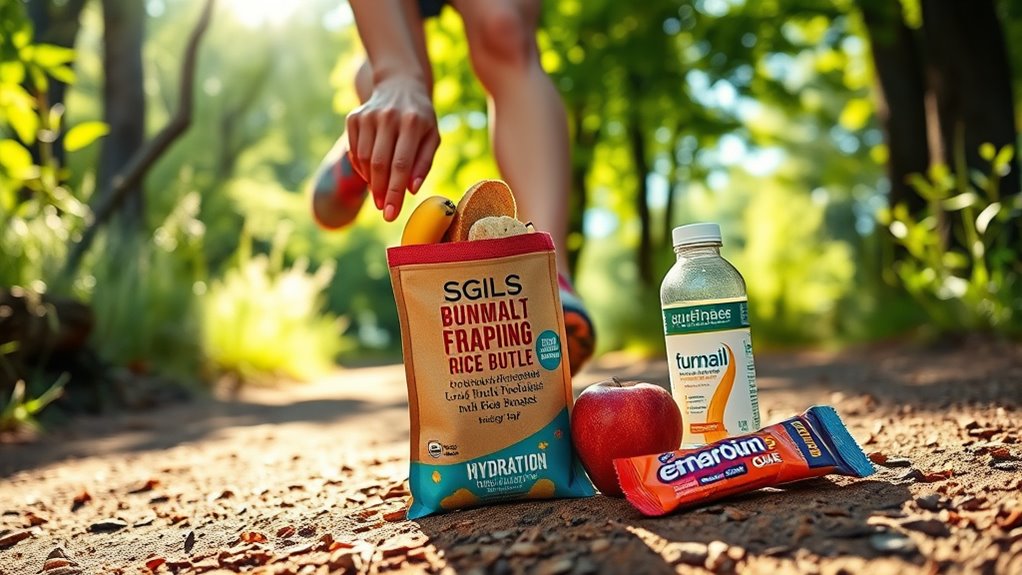If you’re looking to boost your running performance and comfort with low-FODMAP fueling, I recommend options like bananas, rice cakes with peanut butter, boiled potatoes, oats, low-FODMAP granola, hard cheeses, carrots, and plain popcorn. These foods are easy to digest, portable, and help maintain steady energy levels without gut issues. Want to discover more tips to optimize your fuel strategies? Keep exploring for practical advice tailored specifically for runners just like you.
Key Takeaways
- Prioritize low-GI, easily digestible carbohydrate sources like bananas, rice cakes, and oats to sustain energy without gut discomfort.
- Use portable, low-FODMAP snacks such as hard cheeses, nuts, and seed bars for quick fueling during runs.
- Incorporate low-FODMAP fruits and vegetables like carrots, strawberries, and spinach to support gut health and hydration.
- Focus on simple, minimally processed foods with verified FODMAP content to prevent triggering symptoms and ensure consistent performance.
- Balance carbohydrate intake with hydration and electrolytes to optimize recovery, endurance, and overall comfort during long-distance runs.
The Low-FODMAP Diet for Beginners (7-Day Gut Relief Plan)
If you’re a runner looking to improve gut health while maintaining energy levels, the Low-FODMAP Diet for Beginners offers practical guidance tailored for newcomers. This 7-day plan provides easy-to-follow recipes, meal plans, and food lists designed to reduce gastrointestinal issues like IBS and SIBO. Many users report feeling better with delicious, simple dishes that don’t require advanced cooking skills. The book also includes helpful charts and tips, making it easier to navigate the initial elimination phase. While some recipes may include borderline ingredients, the overall approach encourages starting with low-FODMAP foods to support gut healing and sustained energy.
Best For: beginners seeking easy, practical guidance on reducing gut issues like IBS and SIBO through a structured 7-day low-FODMAP meal plan that emphasizes simple recipes and helpful tips.
Pros:
- User-friendly with clear recipes, meal plans, and helpful charts suitable for those new to low-FODMAP dieting.
- Offers a variety of delicious, simple dishes that are easy to prepare without advanced cooking skills.
- Provides valuable tools such as food lists and tips to assist beginners in navigating the elimination phase effectively.
Cons:
- Some recipes include borderline or red FODMAP ingredients, which can complicate adherence during initial elimination.
- Shopping lists can be expensive, contain obscure ingredients, or have typos, leading to potential waste and planning issues.
- The initial meal plan may include ingredients that conflict with low-FODMAP guidelines, requiring careful adaptation for true beginners.
The Low-FODMAP Diet IBS Solution Cookbook
The Low-FODMAP Diet IBS Solution Cookbook is an excellent choice for runners with IBS who want quick, flavorful meals that support digestive health. It offers a science-backed, straightforward approach to managing symptoms, with a 30-day meal plan and easy-to-make recipes. Designed for busy individuals, it includes detailed ingredient guides, troubleshooting tips, and clear instructions, making meal prep hassle-free. The recipes are tagged by FODMAP levels, allowing customization based on tolerance. Many users report symptom relief within days, enjoying meals that taste good and reduce bloating. This resource empowers you to reclaim digestive peace while fueling your runs effectively.
Best For: Runners with IBS seeking quick, flavorful, and digestion-friendly meals to support their active lifestyle.
Pros:
- Provides a science-backed, straightforward approach to symptom management.
- Includes detailed meal plans, shopping lists, and recipes tagged by FODMAP levels for easy customization.
- Features clear instructions and appealing photos, making meal prep simple and enjoyable.
Cons:
- May require initial effort to familiarize oneself with low-FODMAP ingredients and guidelines.
- Some recipes might be too simple for those seeking gourmet or complex dishes.
- The focus on quick meals might limit the variety for those looking for extensive culinary options.
The Complete Paleo Cookbook for Beginners
Looking for a paleo-friendly cookbook that’s easy to follow and packed with practical recipes? The Complete Paleo Cookbook for Beginners is perfect. It offers simple, authentic recipes and meal plans aimed at weight loss and better health. The layout is well-organized, making it accessible even if you’re new to Paleo cooking. Most recipes use common ingredients, requiring minimal effort and time. Many users call it their “Paleo bible” because it’s so helpful. It also includes grocery lists and meal plans, making meal prep easier. Overall, this cookbook makes shifting to Paleo straightforward, enjoyable, and effective for improving your lifestyle and health.
Best For: Beginners seeking straightforward, easy-to-follow Paleo recipes and meal plans to support weight loss and improved health.
Pros:
- Well-organized layout and simple recipes suitable for non-experts
- Includes practical meal plans and grocery lists for convenience
- Uses common ingredients, making recipes accessible and quick to prepare
Cons:
- Some recipes may lack variety or be less favored by experienced Paleo cooks
- Not all recipes may cater to specific dietary restrictions or preferences
- The focus is on simplicity, which might limit the complexity or gourmet options for advanced cooks
The Low-FODMAP Diet for Beginners: 7-Day Gut Relief Plan
Beginners seeking to manage gastrointestinal issues while maintaining an active lifestyle will find the Low-FODMAP Diet for Beginners particularly helpful, as it offers practical guidance and straightforward meal plans. The 7-day gut relief plan provides easy recipes, food lists, and tips to reduce symptoms of IBS and other gut conditions. While some recipes may include borderline ingredients like blueberries or zucchini, the plan emphasizes starting with low-FODMAP foods, followed by a gradual reintroduction phase. The book’s clear instructions and helpful charts make it accessible, but users should adapt recipes to fit their individual tolerances for the best results.
Best For: beginners and individuals with gastrointestinal issues seeking practical, easy-to-follow low-FODMAP meal plans and recipes to manage symptoms and improve gut health.
Pros:
- User-friendly with clear charts, recipes, and meal plans suitable for beginners
- Offers a variety of delicious recipes, including sauces, dips, and desserts, that expand meal options
- Provides valuable guidance on FODMAPs, IBS, and diet management for better understanding and adherence
Cons:
- Some recipes include borderline FODMAP ingredients like blueberries and zucchini, complicating initial elimination phase adherence
- Shopping lists can be expensive, contain obscure ingredients, and have typos, leading to waste and planning difficulties
- Meal plans may be repetitive or impractical for some users due to ingredient restrictions and cost considerations
The Low-FODMAP Diet for Beginners (7-Day Gut Relief Plan)
If you’re starting the Low-FODMAP diet to improve gut health and want a clear, step-by-step plan, the 7-Day Gut Relief Plan in this guide offers practical guidance tailored for newcomers. It provides easy-to-follow recipes, meal plans, and food lists designed to help you manage issues like IBS and SIBO. While many recipes are simple, quick, and family-friendly, some initial meal suggestions include ingredients like blueberries or zucchini that may conflict with the strict elimination phase. The book emphasizes using the Monash app for guidance but requires careful adaptation to avoid foods that could hinder your gut healing process. Overall, it’s a helpful starting point with room for customization.
Best For: beginners seeking a practical, step-by-step low-FODMAP plan to manage gut issues like IBS and SIBO with easy recipes and meal guidance.
Pros:
- User-friendly, with clear recipes, meal plans, and helpful charts tailored for newcomers
- Includes diverse recipes for sauces, dips, and desserts that expand low-FODMAP options
- Kindle version offers adjustable text for better readability and user comfort
Cons:
- Some initial meal plan recipes include ingredients like blueberries and zucchini that conflict with strict elimination guidelines
- Shopping lists can be expensive, contain obscure ingredients, or have typos, leading to waste and difficulty planning
- Certain recipes are basic or obvious, and the plan may require adaptation for beginners to avoid ingredient restrictions
The Low-FODMAP Diet IBS Solution Cookbook
The Low-FODMAP Diet IBS Solution Cookbook is an excellent choice for runners managing IBS who want quick, flavorful meals that support their training without triggering symptoms. It offers a science-backed, straightforward approach with a 30-day meal plan that takes the guesswork out of eating. The recipes are simple, visually appealing, and tagged with FODMAP levels, allowing customization to individual tolerance. Designed for busy lifestyles, it includes shopping lists, clear instructions, and easy-to-follow guidance. Many users experience symptom relief within days, feeling more confident and comfortable. This cookbook truly empowers runners to nourish their bodies while keeping IBS symptoms at bay.
Best For: Runners with IBS seeking quick, flavorful, and customizable low-FODMAP meals that support their training and digestive health.
Pros:
- Provides a comprehensive 30-day meal plan with shopping lists and clear instructions for easy meal prep.
- Recipes are simple, appealing, and tagged with FODMAP levels for tailored dietary management.
- Designed specifically for busy lifestyles, supporting on-the-go access via the Kindle version and minimal time in the kitchen.
Cons:
- May require additional ingredients or spices not included in standard grocery lists.
- Some users might find the 30-day plan limiting after extended use, needing further customization.
- The focus on IBS and low-FODMAP may not address other dietary preferences or restrictions for all users.
The Super Easy Low-FODMAP Diet Cookbook
Designed with busy individuals in mind, The Super Easy Low-FODMAP Diet Cookbook offers straightforward, flavorful recipes that are quick to prepare, making it an excellent resource for runners balancing their training and gut health. With 2000 days of recipes, it helps alleviate IBS symptoms, reduce bloating, and improve digestion. The book’s user-friendly layout, full-color photos, and diverse options—meat, vegetarian, salads, desserts—make meal planning simple. Clear guidance and manageable meal plans ease the progression to low-FODMAP eating. Many users report better digestion and increased energy, proving that enjoyable, gut-friendly meals can support both performance and comfort on busy training days.
Best For: busy individuals and athletes seeking quick, flavorful, and gut-friendly recipes to manage IBS symptoms while maintaining an active lifestyle.
Pros:
- User-friendly layout with full-color photographs and straightforward instructions.
- Diverse recipes including meat, vegetarian, salads, and desserts, catering to various tastes.
- Extensive 2000-day meal plan and clear guidance simplify transitioning to low-FODMAP eating.
Cons:
- Some images may not match the recipes, affecting visual appeal.
- The organization of certain sections, like meal plans, could be more streamlined.
- A few users find some recipes require more effort or harder-to-find ingredients.
The IBS Elimination Diet and Cookbook
For runners managing IBS, “The IBS Elimination Diet and Cookbook” offers practical guidance to help identify trigger foods and maintain a balanced diet. I found it incredibly helpful in orchestrating the complexities of low-FODMAP eating, with clear explanations and step-by-step instructions. The book includes detailed food lists, meal ideas, and tips for tracking progress, making the diet more manageable. Many users report quick symptom relief and the ability to reintroduce foods safely. While the diet can be restrictive, the book provides valuable tools to support long-term management, improving both gut health and overall quality of life.
Best For: individuals with IBS seeking a comprehensive, science-based resource for managing symptoms through diet, especially those who appreciate detailed guidance and practical meal planning tools.
Pros:
- Provides clear, science-grounded explanations of FODMAPs and the diet process.
- Offers detailed food lists, recipes, and step-by-step guidance for managing the diet.
- Includes progress-tracking tools and reintroduction tips to identify personal triggers.
Cons:
- Extensive food lists and digital format may be cumbersome without printable resources.
- The diet’s restrictiveness can be challenging to maintain long-term.
- Some users find the book’s navigation and access to quick-reference information difficult.
Factors to Consider When Choosing Low‑Fodmap Fueling Options for Runners

When selecting low-FODMAP fueling options, I consider several key factors to keep my runs smooth. I look at carbohydrate content and how easily the food digests, making sure it aligns with my energy needs and stomach comfort. Additionally, I check for low-FODMAP ingredients, a suitable glycemic index, and portability for on-the-go snacking.
Carbohydrate Content Balance
Balancing carbohydrate content is vital for runners aiming to fuel effectively without upsetting digestion. Choosing low-FODMAP foods that provide enough energy without triggering symptoms is key. During activity, I recommend aiming for 30-60 grams of carbs per hour, but this varies based on individual tolerance. Combining low-FODMAP carbs with protein and healthy fats can help sustain energy and support digestion. Portion control is also essential—large quantities of low-FODMAP foods can still cause issues, so moderation is important. Proper carbohydrate balancing not only prevents gastrointestinal distress but also guarantees glycogen stores stay topped up for peak performance. By paying attention to these factors, you can optimize your fueling strategy to stay comfortable and energized during every run.
Easy Digestibility Factors
Choosing low-FODMAP fueling options that are easy to digest can make a significant difference in maintaining comfort during runs. Foods low in fermentable carbs, like rice, bananas, or potatoes, require minimal digestion, helping prevent gas and bloating. It’s best to avoid high-fiber or high-fat foods before exercise, as they slow digestion and increase discomfort. Instead, opt for small, frequent meals with moderate amounts of low-FODMAP ingredients to sustain energy without stressing your gut. Remember, individual tolerance varies, so it’s important to test different foods gradually and monitor how your body responds. By focusing on simple, easily digestible options, you can help ensure your fueling supports performance while keeping gastrointestinal issues at bay.
Low-FODMAP Ingredient Compatibility
Selecting the right low-FODMAP ingredients is key to fueling your runs without upsetting your stomach. I focus on ingredients low in fermentable oligosaccharides, disaccharides, monosaccharides, and polyols to prevent gastrointestinal issues. Many common carb sources like wheat, honey, apples, and certain beans are high in FODMAPs and should be avoided. Instead, I turn to safe options like rice, oats, bananas, carrots, and some nuts, which provide reliable energy without gut distress. When choosing foods, I pay close attention to ingredient combinations, steering clear of red or borderline FODMAP items that can trigger symptoms even in small amounts. Using resources like the Monash app helps me verify FODMAP content, ensuring my fueling choices support both performance and comfort during endurance activities.
Glycemic Index Considerations
When fueling for a run, considering the glycemic index (GI) of your foods is essential for maintaining steady energy levels. Low-GI foods release glucose slowly, providing sustained energy throughout long runs, which helps prevent fatigue. Conversely, high-GI foods cause rapid blood sugar spikes followed by crashes, leading to decreased performance and exhaustion. Balancing low-GI options with enough carbohydrates supports stable energy without upsetting your stomach. This approach is especially important pre- and post-workout, as it aids glycogen replenishment and recovery. Incorporating low-GI fueling choices can also improve overall metabolic stability and reduce insulin spikes during extended exercise. Paying attention to GI helps optimize your energy management, ensuring you stay comfortable and perform at your best throughout your runs.
Portable Snack Options
Finding the right portable snack options is essential for maintaining energy and digestive comfort during runs. I look for low-FODMAP snacks that are simple, non-perishable, and easy to carry, like bananas, rice cakes with peanut butter, or hard cheeses. These options are low in fermentable carbs, helping prevent stomach issues on the go. I also prioritize snacks with minimal moisture content to avoid spoilage and guarantee freshness during exercise. Portion control matters too—too much can overload my gut, while too little won’t fuel me properly. Packaging should be lightweight and convenient, fitting easily into my gear or pockets for quick access. By choosing these mindful options, I stay energized without compromising my digestion or comfort during my run.
Flavor and Palatability
Flavor and palatability are key to making low-FODMAP fueling options enjoyable and easy to consume during runs. When your fuel tastes good, you’re more likely to stick with it and meet your energy needs without discomfort. I recommend using herbs, spices, and natural sweeteners to boost flavor without increasing FODMAP content. Texture also matters—smoothies, energy balls, and baked bars offer satisfying mouthfeel that encourages consistent intake. Balancing sweet and savory flavors helps prevent taste fatigue, keeping your palate engaged over long distances. Well-flavored options are more appealing, making it easier to consume adequate amounts for energy and gastrointestinal comfort. Ultimately, finding tasty, satisfying fuel options keeps you motivated and supports your performance goals during every run.
Nutritional Completeness
Choosing low-FODMAP fueling options that are nutritionally complete is essential for maintaining energy levels, supporting recovery, and guaranteeing overall health during training. It’s important to include all essential macronutrients—carbohydrates, proteins, and healthy fats—so your body has what it needs for sustained effort and repair. Incorporating a variety of low-FODMAP fruits, vegetables, grains, and proteins helps prevent nutrient deficiencies and keeps your diet balanced. Many low-FODMAP foods, like quinoa, eggs, and spinach, are nutrient-dense and can easily complement your nutritional goals. Monitoring micronutrients such as iron, calcium, and B vitamins is also vital, especially when restricting certain high-FODMAP foods. A diverse, well-rounded plan ensures you meet your daily caloric and nutrient needs without relying on processed or limited options.
Cost and Accessibility
When selecting low-FODMAP fueling options, considering cost and accessibility can make a big difference in sticking to your nutrition plan. Cost-effective choices often include common, minimally processed foods like bananas, oats, and rice, which are easy to find at most grocery stores. Accessibility varies by region; some specialty ingredients may be hard to locate, increasing expenses and complicating meal prep. Preparing meals at home tends to be cheaper than buying pre-packaged or specialty products, helping you save money over time. The availability of low-FODMAP foods in local markets influences how easily you can maintain your diet without frequent store visits or online orders. Keep in mind that some ingredients, like certain nuts or gluten-free grains, can be costly, impacting your long-term adherence on a budget.
Frequently Asked Questions
Are There Specific Low-Fodmap Snacks Ideal for Pre-Run Fueling?
Yes, I recommend low-FODMAP snacks like bananas, rice cakes with peanut butter, or a small handful of trail mix with allowed nuts. These options give me quick energy without upsetting my stomach. I prefer eating them about 30 minutes before my run. They’re easy to digest and keep me fueled without causing discomfort. You might find these snacks work well for you too, helping boost your performance comfortably.
How Do Low-Fodmap Options Compare to Traditional Sports Gels?
Low-FODMAP options are like a refreshing gust compared to traditional sports gels. They often contain fewer artificial ingredients and are gentler on my stomach, helping me avoid discomfort during runs. While gels pack quick energy, low-FODMAP choices like ripe bananas or rice cakes provide sustained fuel without the bloating or cramping. I find balancing both gives me the best of both worlds—performance and comfort.
Can Low-Fodmap Foods Sustain Energy During Long-Distance Runs?
Yes, low-FODMAP foods can sustain my energy during long-distance runs when I choose the right options. I rely on low-FODMAP carbs like bananas, rice cakes, and oats, which digest easily and provide steady energy. I also incorporate small amounts of low-FODMAP nut butters for healthy fats. With proper planning, I find these foods keep me energized without causing digestive issues, making my long runs more comfortable and effective.
What Are the Best Low-Fodmap Hydration Strategies for Runners?
You might think staying hydrated on a low-FODMAP diet is tricky, but it’s totally doable. I recommend sipping water regularly, adding electrolyte tablets without high-FODMAP ingredients, and choosing low-FODMAP drinks like coconut water or homemade sports drinks. Avoid sugary or artificial options that can cause discomfort. Staying consistent with hydration helps maintain energy and prevents cramps, so I always plan my intake before and during my runs.
Are There Any Low-Fodmap Supplements Recommended for Endurance Athletes?
Yes, I recommend low-FODMAP electrolyte drinks and magnesium supplements for endurance athletes. These help maintain hydration, prevent cramps, and support recovery without upsetting my digestive system. I find that choosing products with simple ingredients and avoiding high-FODMAP additives makes a big difference. Always check labels carefully and consider consulting a dietitian to tailor supplements to your specific needs, ensuring you stay fueled and comfortable during long runs.
Conclusion
Choosing the right low-FODMAP fueling options can feel overwhelming, but trust me, once you find what works, your runs will reach new heights—like soaring beyond the clouds! It’s all about listening to your gut and fueling smartly. With patience and experimentation, you’ll discover your true running potential and enjoy comfort on every mile. Don’t settle for less—your best runs are just a low-FODMAP choice away!















